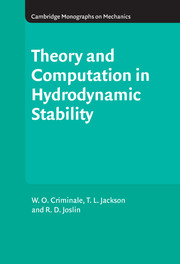Book contents
- Frontmatter
- Contents
- Figures
- Tables
- Preface
- 1 Introduction and problem formulation
- 2 Temporal stability of inviscid incompressible flows
- 3 Temporal stability of viscous incompressible flows
- 4 Spatial stability of incompressible flows
- 5 Stability of compressible flows
- 6 Centrifugal stability
- 7 Geophysical flow
- 8 Transient dynamics
- 9 Nonlinear stability
- 10 Transition and receptivity
- 11 Direct numerical simulation
- 12 Flow control and optimization
- 13 Investigating hydrodynamic instabilities with experiments
- References
- Author index
- General index
1 - Introduction and problem formulation
Published online by Cambridge University Press: 06 July 2010
- Frontmatter
- Contents
- Figures
- Tables
- Preface
- 1 Introduction and problem formulation
- 2 Temporal stability of inviscid incompressible flows
- 3 Temporal stability of viscous incompressible flows
- 4 Spatial stability of incompressible flows
- 5 Stability of compressible flows
- 6 Centrifugal stability
- 7 Geophysical flow
- 8 Transient dynamics
- 9 Nonlinear stability
- 10 Transition and receptivity
- 11 Direct numerical simulation
- 12 Flow control and optimization
- 13 Investigating hydrodynamic instabilities with experiments
- References
- Author index
- General index
Summary
History, background, and rationale
In examining the dynamics of any physical system the concept of stability becomes relevant only after first establishing the possibility of equilibrium. Once this step has been taken, the concept becomes ubiquitous, regardless of the actual system being probed. As expressed by Betchov & Criminale (1967), stability can be defined as the ability of a dynamical system to be immune to small disturbances. It is clear that the disturbances need not necessarily be small in magnitude but the fact that the disturbances become amplified as a result and then there is a departure from any state of equilibrium the system had is implicit. Should no equilibrium be possible, then it can already be concluded that that particular system in question is statically unstable and the dynamics is a moot point.
Such tests for stability can be and are made in any field, such as mechanics, astronomy, electronics and biology, for example. In each case from this list, there is a common thread in that only a finite number of discrete degrees of freedom are required to describe the motion and there is only one independent variable. Like tests can be made for problems in continuous media but the number of degrees of freedom becomes infinite and the governing equations are now partial differential equations instead of the ordinary variety. Thus, conclusions are harder to obtain in any general manner but it is not impossible.
- Type
- Chapter
- Information
- Theory and Computation of Hydrodynamic Stability , pp. 1 - 23Publisher: Cambridge University PressPrint publication year: 2003



